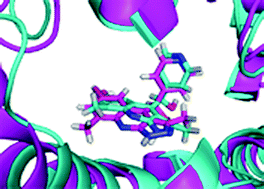Inhibition mechanism exploration of quinoline derivatives as PDE10A inhibitors by in silico analysis†
Abstract
As a potential target for the treatment of schizophrenia, the dual cAMP/

* Corresponding authors
a
Microscale Science Institute, Weifang University, Weifang, Shandong, China
E-mail:
wuqianwq2006@163.com
Tel: +86 536 8785283
b School of Chemical Engineering, Weifang Vocational College, Weifang, China
c
Department of Materials Science and Chemical Engineering, Dalian University of Technology, Dalian, Liaoning, China
E-mail:
yanli@dlut.edu.cn
Tel: +86 411 84986062
d Lab of Pharmaceutical Resource Discovery, Dalian Institute of Chemical Physics, Graduate School of the Chinese Academy of Sciences, Dalian, Liaoning, China
As a potential target for the treatment of schizophrenia, the dual cAMP/

 Please wait while we load your content...
Something went wrong. Try again?
Please wait while we load your content...
Something went wrong. Try again?
Q. Wu, Q. Gao, H. Guo, D. Li, J. Wang, W. Gao, C. Han, Y. Li and L. Yang, Mol. BioSyst., 2013, 9, 386 DOI: 10.1039/C2MB25501D
To request permission to reproduce material from this article, please go to the Copyright Clearance Center request page.
If you are an author contributing to an RSC publication, you do not need to request permission provided correct acknowledgement is given.
If you are the author of this article, you do not need to request permission to reproduce figures and diagrams provided correct acknowledgement is given. If you want to reproduce the whole article in a third-party publication (excluding your thesis/dissertation for which permission is not required) please go to the Copyright Clearance Center request page.
Read more about how to correctly acknowledge RSC content.
 Fetching data from CrossRef.
Fetching data from CrossRef.
This may take some time to load.
Loading related content
